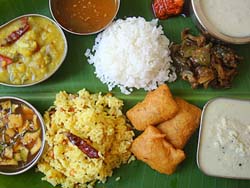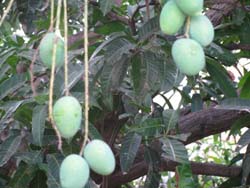| Ugadi |
 |
The New year festival or Ugadi comes close on the heels of Holi. While the strong colors of Holi start fading away, the freshness of spring lingers on with sprightliness all around. The flame of the forest (trees with bright red flowers that blossom during holi) are in full bloom signifying an affluent season.
It is believed that the creator of the Hindu pantheon Lord Brahma started creation on this day - Chaitra suddha padhyami or the Ugadi day. Also the great Indian Mathematician Bhaskaracharya's calculations proclaimed the Ugadi day from the sunrise on as the beginning of the new year, new month and new day. The onset of spring also marks a beginning of new life with plants (barren until now) acquiring new life, shoots and leaves. Spring is considered the first season of the year hence also heralding a new year and a new beginning. The vibrancy of life and verdent fields, meadows full of colorful blossoms signifies growth, prosperity and well-being.
|
 |
With the coming of Ugadi, the naturally perfumed jasmines (mallepulu) spread a sweet fragrance which is perhaps unmatched by any other in nature's own creation! While large garlands of jasmine are offered to Gods in homes and temples, jasmine flowers woven in clusters adorn the braids of women.
Ugadi marks the beginning of a new Hindu lunar calendar with a change in the moon's orbit. It is a day when mantras are chanted and predictions made for the new year. |
Traditionally, the panchangasravanam or listening to the yearly calendar was done at the temples or at the Town square but with the onset of modern technology, one can get to hear the priest-scholar on television sets right in one's living room.
It is a season for raw mangoes spreading its aroma in the air and the fully blossomed neem tree that makes the air healthy. Also, jaggery made with fresh crop of sugarcane adds a renewed flavor to the typical dishes associated with Ugadi.
The Vallamkali (boat race) is one of the main attractions of Onam, and is best seen at Aranmulai and Kottayam. About a hundred oarsmen row huge and graceful odee (boats). Oars dip and flash to the rhythm of drums and cymbals in each boat. The songs are generally typical in character and concern people well known in Malabar. Above each boat gleam scarlet silk umbrellas: their number denotes the affluence of the family owning the boat. Gold coins and tassels hang from the umbrellas.
"Ugadi pachchadi" is one such dish that has become synonymous with Ugadi. It is made of new jaggery, raw mango pieces and neem flowers and new tanarind which truly reflect life - a combination of sweet, sour and bitter tastes!
|
 |
Ugadi is celebrated with festive fervor in Maharashtra, Karnataka and Andhra Pradesh. While it is called Ugadi in A.P. and Karnataka, in Maharashtra it is known as "Gudipadava".
Preparations for the festival begin a week ahead. Houses are given a thorough wash. Shopping for new clothes and buying other items that go with the requirements of the festival are done with a lot of excitement. |
On Ugadi day, people wake up before the break of dawn and take a head bath after which they decorate the entrance of their houses with fresh mango leaves. The significance of tying mango leaves relates to a legend. It is said that Kartik (or Subramanya or Kumara Swamy) and Ganesha, the two sons of Lord Siva and Parvathi were very fond of mangoes. As the legend goes Kartik exhorted people to tie green mango leaves to the doorway signifying a good crop and general well-being.
It is noteworthy that mango leaves and coconuts (as in a Kalasam, to initiate any pooja) are used only on auspicious occasions to propitiate gods.People also splash fresh cow dung water on the ground in front of their house and draw colorful floral designs. This is a common sight in every household. People perform the ritualistic worship to God invoking his blessings before they start off with the new year. They pray for their health, wealth and prosperity and success in business too. Ugadi is also the most auspicious time to start new ventures.
The celebration of Ugadi is marked by religious zeal and social merriment. Special dishes are prepared for the occasion. In Andhra Pradesh, eatables such as "pulihora", "bobbatlu" and preparations made with raw mango go well with the occasion. In Karnataka too, similar preparations are made but called "puliogure" and "holige". The Maharashtrians make "puran poli" or sweet rotis.
Ugadi is thus a festival of many shades. It ushers in the new year, brings a rich bounce of flora and fills the hearts of people with joy and contentment!
|
|
|
| Religions |
In India, religion is a way of life. It is an integral part of the entire Indian tradition. For the majority of Indians, religion permeates every aspect of life, from common-place daily chores to education and politics. Secular India is home to Hinduism, Islam, Christianity, Buddhism, Jainism, Sikhism and other innumerable religious traditions. Hinduism is the dominant faith, practised by over 80% of the population. Besides Hindus, Muslims are the most prominent religious group and are an integral part of Indian society. In fact India has the second largest population of Muslims in the world after Indonesia.
|
| Read more about Indian Religions |
|
|
